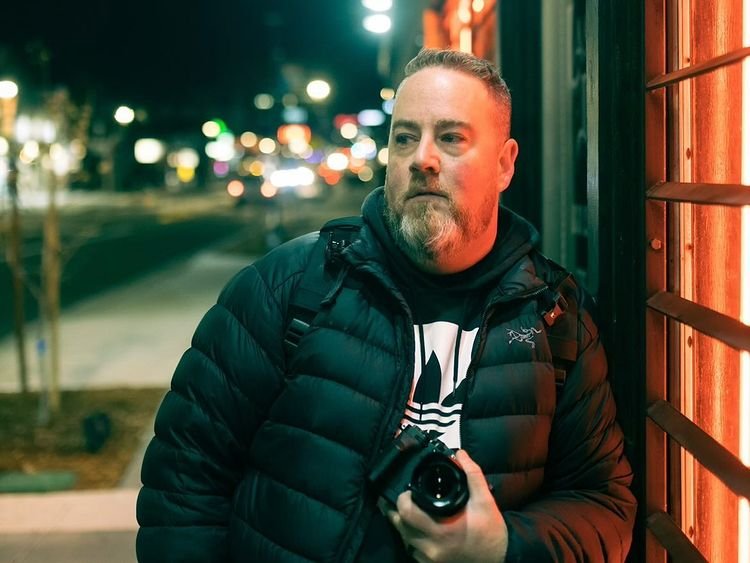Ben Davis has been behind the lens for a long time. His latest project, Reno After Dark, which can be found on Instagram is becoming a living historical document of how Reno is changing. Davis moved to Reno in 2010 for work; however he has always had connections to the Silver State. His family came to Nevada and laid down their roots outside of Ely working at a copper mine. His mom left the state, breaking a multigenerational run, but he returned.
A pandemic project that is turning into a historical document on the shifting face of Reno is nearly a year old. For local photographer Ben Davis, he sees his work becoming a medium to educate Reno about what downtown is and as a tool to promote improving the downtown corridor.
“I came out one evening, figured out that Reno’s got a lot of bright lights and the town sort of comes alive at night,” said Davis. He is the person behind the Instagram account Reno After Dark. At the encouragement of his wife, he began spending evenings downtown a year ago and creating images at night. Over this time he has seen people throw things out the window from the former Harrah’s casino, a near riot and tense conflict between a large crowd and a handful of police officers under the Reno Arch. He’s seen more and more motels get demolished and replaced with empty fenced lots.
For Davis, whose bread and butter photography is corporate, commercial and event based, this is a way for him to push his creative skillset and improve as a photographer.
“My dad bought me my first film camera when I was 10 and that sort of laid the foundation for photography,” he explained. He quickly realized the analog format was too slow for him and without the instant gratification, moved onto graphic design. A quick look into his photography shows his background as a graphic designer. He would return to photography when he purchased his first digital camera in 2005.
“Street photography is probably one of the harder genres of photography because you’re trying to take something that in of itself might be boring,” he explained. It is a process that he constantly finds a challenge in and by getting out one or two days a week to create these images continues to grow creatively. “You’re trying to make it interesting for people and look for the art in it.”
“I wanted to show the world a little bit of the things that make Reno unique,” explained Davis.
He spends usually a Friday and or Saturday evening roaming the streets of the downtown corridor, looking for ways to make the normal interesting. To get people to look at scenes they take for granted in a new light. Some nights he tries to tell the story of what Reno is on that particular evening. Other times he challenges himself to make images of only red subjects. It is a scavenger hunt for him each night.
“The other interesting thing too is a lot of locals don’t come down to downtown,” Davis said. He treats his work as a way to illustrate what locals are missing by not visiting the heart of town. He hopes his work can serve as a method of advocacy for improving what downtown is and making Reno a better, safer, more enjoyable place.
“I don’t think most locals appreciate how much of downtown Jacobs [Entertainment] has purchased and that there hasn’t been a whole lot of public debate about it,” he said referring to the ongoing acquisition of property by the Cleveland-based company. He is concerned about the process of having that much land in a developer's hands and not having an open and valuable public conversation about the goals and vision for the future. “I think that’s kind of scary a little bit.”
As night photography project continues into a second year, Davis is hopeful his body of work will serve as a historical document of what Reno was and is becoming. He remembers snapshots he created over seven years ago that showcase a far different Reno. He has no plans to wrap this project up and looks forward to getting out there each night and creating color-rich images of what Reno is becoming.
Being a street photographer, Davis also faces ethical challenges. The lifelong debate about creating a photograph of a person in a public space is something he thinks of every time he presses the shutter button. He acknowledges that it is not okay to photograph people in a vulnerable state, such as the unhoused, but understands that we live in a surveillance state. By walking in a public space, people agree to be photographed.
Legally, under the First Amendment, photographers can create images of people without their permission. It is when the photographer becomes obnoxious, confrontational, or creates the images with bad intent the ethics are challenged.
“I try to be respectful to people that are out and about,” he said. “I want to be out of the way.” As a documentarian, he wants to observe and be a fly on the wall of what is happening downtown. “I try to represent them [people] fairly.”
Davis’s work can be found online at www.RenoAfterDark.com. His work is defined by vibrance colors and bleeds neon. “I feel like I have a good pulse of the city,” he explained. “I like to advocate for the city,” he said.


